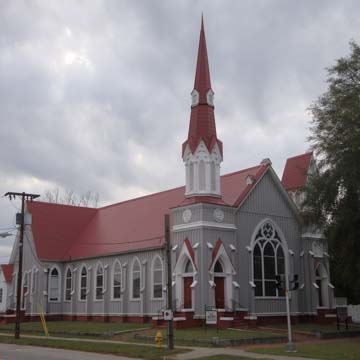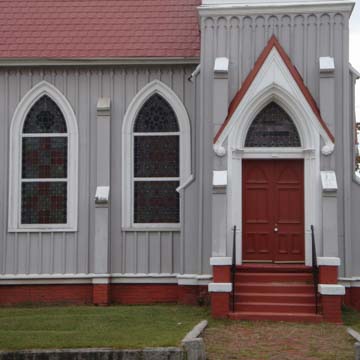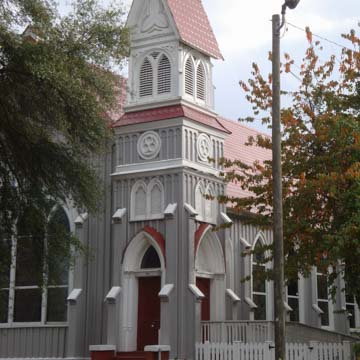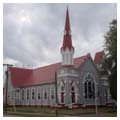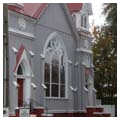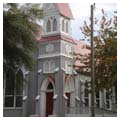Union Baptist Church is a Carpenter Gothic church originally built about 1851 as the second Presbyterian church in Augusta. During the Civil War the building served as a Sunday school for African Americans, and continued serving a black Methodist congregation after the war. In 1883 a Baptist group, established in 1878 as the Union Baptist congregation, acquired the Greene Street building and hired architectural firm MacMurphy and Story to enlarge and remodel the structure in 1887–1888. The fully developed board-and-batten church that survives today is the result, and it remains one of the finest Carpenter Gothic buildings in the state.
The Union Baptist Church features an asymmetrical front, with two entrance towers at either end. Balance and uniformity are achieved by the towers’ equal-height bases, the circle with trefoil on both towers, the white cap trim at two set-back levels on the buttresses, and by the attic level, which is defined on each tower by a strong horizontal white stringcourse. These features accented in white stand out against the dominant gray background of the structure. These similar elements serve to emphasize the differing and picturesque superstructures atop each tower, and their architectural detail. The main entry tower, on the corner of Greene and Eleventh streets, displays a prominent arch trim and gable cap above the doorway and a multi-staged steeple; the lower section of the steeple lines up gabled cuspate arches and is topped by an elongated, polygonal, witch’s hat roof with four petite dormers. The secondary tower entrance has smaller-scaled, pointed arch trim with paired lancets above; it is crowned with a gabled belfry.
Between the two towers is a large window presenting a simplified variation of Geometric Decorated tracery pattern, while side windows are simple Early English lancets with no tracery. The march of side buttresses serve no structural purpose, and in their thinner proportions contribute to the linear character of the board-and-batten aesthetic. A recent restoration presents a harmonious interplay of red roofs and foundation, gray body and white trim, with a balance that serves a truly outstanding work of architecture.
Union Baptist Church continues to serve an active congregation. It is one of several churches along Greene Street, one of downtown Augusta’s major institutional and residential streets. The Presbyterians who initially built this structure relocated to a Romanesque Revival church (1906), one of Augusta’s most prominent religious edifices, a block and a half west.
References
Montgomery, Erick. “Symbols of Black History.” Augusta Magazine (February-March 2011).

